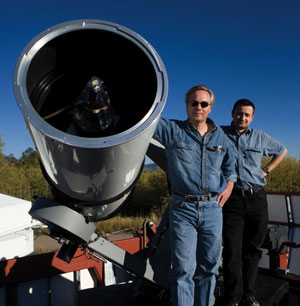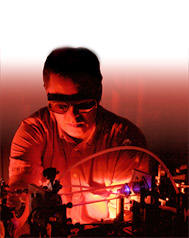About LANL
About Our Capabilities, Facilities, and Staff
"Los Alamos National Laboratory plays an indispensable role in building America as a science and technology powerhouse, and our staff are an incredible resource to the nation and the world." Michael Anastasio, Dir.
Solving Complex R&D Problems with Special Blend of Staff, Capabilities and Facilities
Now in its seventh decade, LANL remains among a very few laboratories that can bring great breadth of fundamental and discovery science, technology, and engineering rapidly together to create tangible solutions for national security needs.
Our staff, working with partners throughout science and industry, must be able to deliver today's solutions while maintaining the depth of capabilities to deliver the next generation of discoveries.
Los Alamos has demonstrated a cycle of innovation where we have developed world-leading capabilities and facilities in response to urgent, unique missions. We also spin out new discoveries that lead to emerging missions.
Being able to integrate and apply our capabilities rapidly to new challenges will be a key advantage in an increasingly competitive landscape.
Our Science, Technology and Engineering Priorities
Science that Matters
- Information science and technology enabling integrative and predictive science
- Experimental science focused on materials for the future
- Fundamental forensic science for nuclear, biological, and chemical threats
How We Work
- Collaborate, partner and team to make decisive contributions to our sponsors
- Outstanding operational excellence for safety, security, and efficient pursuit of ST&E for our missions
Transform Our Scientific Campus
- Campus for 2020 (consistent with complex transformation)
- Modern science facilities: LANSCE refurbishment, CMR replacement, Science Complex
- Signature facilities for experimental science (MaRIE) and computational science (Roadrunner)
More About This Science
Gamma-Ray Bursts
Cosmic gamma-ray bursts, pulses of gamma rays, were detected in 1967 by the Vela satellites (sent into orbit to monitor the 1963 U.S.-Soviet Union treaty banning nuclear weapon tests in the atmosphere). The bursts' extreme energy output has continued to puzzle astrophysicists, but a general picture has emerged.
Rotating matter, in the form of a massive star or a pair of compact objects (such as two neutron stars or a neutron star and black hole) can reach a stage at which the force of its own gravity causes it to spiral inward. Because the matter is rotating, it also experiences a centrifugal force that opposes the inward motion.
Gravity usually wins out, and most of the matter collapses to a point, forming a black hole-a region of space whose gravitational force is so strong that nothing can escape it, not even light. As matter plummets to the point of no return, it releases a huge amount of gravitational energy.
Now the picture gets fuzzier. In some unknown fashion, a fraction of that energy gets trapped in a disk of matter that was held back by centrifugal force and now rotates around the black hole.
The matter in the disk reaches velocities close to the speed of light and turns into a fireball consisting of electrons, positrons, protons, gamma rays, and probably magnetic fields. The fireball expands outward, forming a jet. As this jet of radiating matter and magnetic energy shoots into space at nearly the speed of light, it sweeps up whatever matter is in its path, producing a blast wave of gamma rays lasting tens of seconds on average.
In its wake, the jet leaves hot, glowing material that produces a so-called afterglow (photons of much lower energy than gamma rays) lasting hours or days. The afterglow supplies information concerning the environment around the source of the gamma burst and further constrains how the burst might be generated.
Contact: Przemek Wozniak, (505) 667-1381
A Mind of Its Own
RAPTOR telescope acts alone—unlocking the universe for astronomers

Quick read
The RAPTOR robotic telescope array patrols the night sky, detecting anomalies without human intervention.
On the night of February 6, 2006, Los Alamos astrophysicist Przemek Wozniak was awakened by a cell-phone call from RAPTOR, the small robotic optical telescope array on Fenton Hill, about 30 miles from Los Alamos in northern New Mexico's Jemez Mountains. RAPTOR had found something strange—a rapidly rising light signal coming from the position of a very short gamma-ray burst detected and located. These bursts announce the birth of stellar-size black holes and are the most powerful events since the Big Bang.
Following its own logic, RAPTOR recorded the light signal every 30 seconds and noted a doubling in brightness over four minutes—an afterglow that was rising rather than fading. Running real-time analysis software, RAPTOR decided to report the anomaly to a human.
"This was a first, an autonomous optical telescope finding an anomaly on its own with no human intervention,” said Verstrand. "If humans had been in the loop they would have said, as we did, 'Gamma-ray bursts don't act like that. Forget it.' And RAPTOR wouldn't have found anything."
The quick response allowed astronomers to study the phenomenon for an unprecedented six and a half minutes, unlocking key mysteries.

RAPTOR's observation of that spectacular "rebrightening" hints that a gamma-ray burst can sometimes "turn itself on" a second time, emitting intense visible light but no gamma rays—an intriguing possibility.
For the RAPTOR team, the discovery had a broader significance. It was proof that RAPTOR has a mind of its own—truly a thinking telescope system.
The Los Alamos team is working to make RAPTOR a "discovery engine" for astronomy, scanning the entire night sky frequently, screening a hundred million visible objects and alerting us to something important.
Patrolling the Mutable Heavens
There are many kinds of optical transients, not just those from gamma-ray bursts, and they tell us about the dynamic evolution of the universe. Because bursts are found in the very-early universe, their bright afterglows may also teach us about the environments in which the first stars were born.
In 2012 the National Science Foundation and the Department of Energy plan to initiate a very deep all-sky optical survey using the Large Synoptic Survey Telescope (LSST), an 8.4-meter telescope with a billion-pixel digital camera that will see halfway across the universe and pick up tens of thousands of optical transients every night.
"The LSST could drown us in a flood of data," says Wozniak, "unless we have autonomous systems in place that are able to recognize the interesting events and follow up with real-time observations. Those systems will have to learn and evolve over time if we are to make sense of the dynamic database that is the night sky."
Violent Explosions in the Universe

When Los Alamos scientists began building robotic telescopes 10 years ago, gamma-ray bursts were making headlines because their location in the universe was finally becoming known.
The race was on to see more of these bursts and to follow up each NASA satellite gamma-ray alert with studies of lower-energy signals (x-ray, optical, infrared, radio) that might hint at the source, or "central engine," of the gigantic energy release.
Because these short-lived explosions occur only three or four times a day at random places in the universe, it seemed that optical telescopes, which must wait for satellites to spot the bursts, would never be able to follow up quickly enough to discover if an optical signal accompanied the burst itself. They would see only the afterglow that followed. Then, in a series of tour-de-force measurements, Los Alamos robotic telescopes did the impossible.
A Burst Caught in the Act
On January 23, 1999, RAPTOR's predecessor, ROTSE-I (Robotic Optical Transient Search Experiment-I), responded to a NASA gamma-ray burst alert and within 10 seconds recorded the very-early afterglow, the most-luminous optical source detected up to that time but not part of the burst itself.
Vestrand and team improved and transformed ROTSE-I into the first generation of RAPTOR. Modeled on human vision, it had four small lenses that acted like the eye's peripheral vision and a central telephoto lens that captured the fine details.
Two of these systems placed 38 miles apart saw a patch of sky from two slightly different viewing angles (stereovision). A central command computer (RAPTOR's brain) continuously compared the two views to distinguish distant from nearby (mostly man-made) astrophysical objects and automatically remove thousands of small data glitches, such as equipment noise and cosmic-ray hits.
Vestrand comments, "This distributed and yet integrated operation of robotic telescopes and data systems was the heart of RAPTOR and the 'thinking telescopes' concept from the very beginning."
By December 19, 2004, a second-generation RAPTOR, with a larger 0.4-meter telescope and larger high-speed mount, was able to respond in only 8 seconds to a gamma-ray burst alert from Swift. The NASA satellite had seen a small gamma-ray pulse that turned out to precede the main burst by several minutes. RAPTOR was in position to record the optical emission throughout the burst and beyond. The recording revealed a complete surprise: the first-ever recording of what is now called "prompt" optical emission.
On August 20, 2005, RAPTOR recorded another long burst that confirmed the previous findings. It also allowed scientists to say with a great degree of confidence that gamma-ray bursts have two distinct types of optical emissions contemporaneous with the gamma rays: the newly discovered prompt optical emission and the very-early afterglow, which starts up almost simultaneously. It's like a sudden energy release from an explosive charge, accompanied by embers glowing in the path of the blast wave.
Significance of the Optical Signals
RAPTOR's discoveries have set the stage for us to learn more about the central engine driving gamma-ray bursts and the medium immediately surrounding them.
The brightness of the optical signals suggests that RAPTOR could search independently for gamma-ray bursts without waiting for a satellite's gamma-ray alert. The afterglow's dramatic "rebrightening" that RAPTOR reported to Wozniak suggests that even more "optically rich," high-energy phenomena may exist and that they can be discovered only by surveying the sky for visible light. Each transient astrophysical phenomenon represents an area of intense interest that scientists want to study in depth.
But is it really possible to detect these short cosmic explosions from their optical signals alone, considering the complexity of the night sky? The gamma-ray sky is almost empty but for the few lone gamma-ray bursts and several hundred very faint persistent sources. By comparison, the visible sky is a maelstrom of flickering objects—satellites, airplanes, space debris, cosmic rays, meteors, asteroids, comets, flaring stars, active galactic nuclei, exploding novae, supernovae, and the rare optical transients from gamma-ray bursts—observed against a static backdrop of billions of ordinary stars and galaxies.
"The next version of RAPTOR will be a powerful new tool for searching out previously unknown phenomena within the maelstrom," comments Vestrand.
RAPTOR's next incarnation will collect and analyze the plethora of optical transients at unprecedented rates. A wide-field system such as the 16-lens RAPTOR-K will "harvest" time histories of all objects up to 10,000 times fainter than those detectable with an unaided eye. Tens of thousands of images collected every night, roughly 1 terabyte (a trillion units of data) per week, will be processed within seconds of collection and then compared with an enormous body of stored data on the time history of the night sky.
Emerging transient objects will be reported automatically while they are still occurring, giving response instruments enough time to make otherwise-impossible observations.
The speed of the system will continue to set records, but the truly revolutionary aspect is the introduction of "thinking" software agents that can carry on two-way conversations between the central decision-making computer—all with no human intervention.

Table-top lasers compete with large accelerators
George Rodriguez adjusts argon gas pressure inside two-color plasma ionization gas cells
Table-top ultrafast laser based plasma terahertz sources are beginning to rival pulse energies previously obtainable only at large accelerator-based facilities.
Currents, the Laboratory's monthly employee magazine, highlighting people in the workplace.







